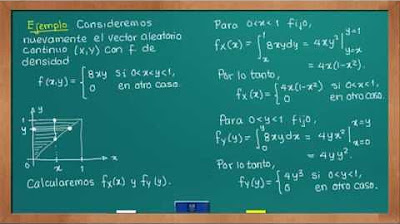POWER SPECTRAL DENSITY OF RANDOM PROCESS
Summary
TLDRThe video script delves into the concept of power spectral density and the analysis of random processes in digital communication. It introduces the topic with an overview of previous videos on random processes and then discusses the transmission of random processes through linear filters. The script covers the mathematical representation of convolution integrals and the properties of expected values and variances in the context of wide-sense stationary processes. It also explains the Fourier transform of autocorrelation functions and the inverse relationship, leading to the definition of the power spectral density. The educational content is aimed at students studying signal processing and communication systems, providing a detailed exploration of the theoretical foundations.
Takeaways
- 📚 The video discusses the topic of power spectral density and the autocorrelation function of random processes, focusing on the concepts from digital communication.
- 📈 The script explains the process of transmitting random processes through linear filters and the importance of understanding signals and systems in this context.
- 🔍 It covers the concepts of continuous and discrete signals, and how they are treated differently in linear convolution and discrete convolution.
- 📚 The video introduces the concept of the impulse response of a system and how it is used to determine the output when an input is applied.
- 🔢 The script delves into mathematical formulations, including the convolution integral, which is key to understanding how signals are processed within a system.
- 📉 The video explains the process of expectation and how it is used to calculate the expected value of both sides of an equation, which is crucial in signal processing.
- 📝 It discusses the properties of the autocorrelation function and how it is represented in the time and frequency domains.
- 🔧 The script covers the application of wide-sense stationary processes and how they are used to simplify the analysis of random processes.
- 📊 The video explains the concept of the power spectral density and its properties, including its relation to the autocorrelation function.
- 📐 The script provides a step-by-step walkthrough of solving integrals related to the properties of random processes, which is essential for understanding signal transmission.
- 🎓 The video concludes with a discussion on the properties of Gaussian random processes and their significance in signal processing, emphasizing the importance of understanding these concepts for students.
Q & A
What is the main topic of the video?
-The main topic of the video is the Power Spectral Density (PSD) of random processes, including the concepts of linear time-invariant systems and their impulse responses.
What is meant by a 'random process' in the context of this video?
-In this video, a 'random process' refers to a sequence or signal that is not deterministic and has some degree of randomness, which can be analyzed using statistical methods.
What is the significance of the impulse response in the context of linear time-invariant systems?
-The impulse response of a linear time-invariant system is significant because it describes the system's reaction to a brief input signal, or impulse, and it is used to determine the system's output for any given input.
How is the concept of 'convolution' related to the discussion of random processes in the video?
-Convolution is related to random processes as it is a mathematical operation that combines two functions to produce a third function that represents how the shape of one is modified by the other. In the context of the video, it is used to analyze the output of a system when a random process is applied as input.
What is the role of the expectation (E) in the equations discussed in the video?
-The expectation (E) in the equations is used to calculate the expected value or mean of a random variable, which is a fundamental concept in understanding the behavior of random processes.
What is the difference between a continuous signal and a discrete signal as mentioned in the video?
-A continuous signal is one that can take any value within a given range over a continuum of time, whereas a discrete signal is one that is defined at specific points in time and can only take on a finite number of values.
Can you explain the term 'Fourier Transform' as it is used in the video?
-The Fourier Transform in the video is a mathematical technique that transforms a time-domain signal into its frequency-domain representation, allowing for the analysis of the frequency components of a signal.
What is the purpose of the 'autocorrelation function' in the analysis of random processes?
-The autocorrelation function is used to measure the correlation of a signal with a delayed copy of itself. It provides insights into the similarity of a signal at different points in time and is crucial for understanding the statistical properties of random processes.
How does the 'Gaussian process' relate to the properties of random processes discussed in the video?
-A Gaussian process is a type of random process where any finite collection of its random variables is multivariate normally distributed. It is mentioned in the video as an example of a process with specific properties, such as being stationary.
What are the properties of the 'PSD' that are discussed in the video?
-The properties of the Power Spectral Density (PSD) discussed in the video include its representation of the power of a signal in the frequency domain, its relation to the autocorrelation function through the Wiener-Khinchin theorem, and its importance in understanding the power distribution of a random process.
What is the concept of 'stationarity' in the context of random processes?
-In the context of random processes, 'stationarity' refers to a property where the statistical properties of the process do not change over time. A stationary process maintains a constant mean and autocorrelation function over time.
Outlines

此内容仅限付费用户访问。 请升级后访问。
立即升级Mindmap

此内容仅限付费用户访问。 请升级后访问。
立即升级Keywords

此内容仅限付费用户访问。 请升级后访问。
立即升级Highlights

此内容仅限付费用户访问。 请升级后访问。
立即升级Transcripts

此内容仅限付费用户访问。 请升级后访问。
立即升级浏览更多相关视频

What is White Gaussian Noise (WGN)?

Understanding Power Spectral Density and the Power Spectrum

Random Variables and Probability Mass/Density Functions

0625 Función de densidad conjunta, marginal y condicional

Weibull Distribution and Moment generating function (mgf) of Weibull Distribution in statistics|

I Prodigi della TRASFORMATA di FOURIER
5.0 / 5 (0 votes)
